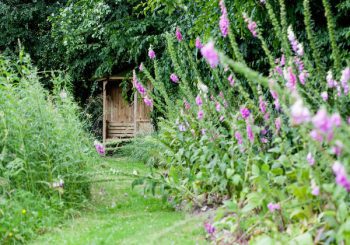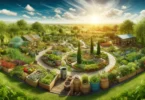By Jane Marsh
Guest Writer for Wake Up World
Staring out the window into your backyard to find birds flying about, butterflies hopping from bush to bush, and chipmunks scurrying through the garden is a picturesque scene many people often dream about.
While some homeowners are perfectly fine setting up a couple of lounge chairs on the patio for an afternoon with a good book, others want more from their outdoor living area.
Wildlife can add a new level of happiness and excitement to your backyard. However, most of our yards aren’t designed to attract numerous species. The four most vital elements of wildlife habitat are food, water, cover, and space.
If you’re looking to turn your backyard into a one-stop destination for animals and insects, you need to plan accordingly. Here are six ways to turn your backyard into a wildlife haven.
1. Choose Native Plants
When choosing plants for your backyard wildlife sanctuary, opt for native flora that’s naturally adapted to your area’s soil and climate conditions. Attracting wildlife to your backyard is a lot easier when you provide the nectar, pollen, and seeds that native species enjoy.
According to the U.S. Department of Agriculture (USDA), there are several environmental benefits of including native plants in your outdoor space, including:
- Native plants require fewer pesticides and no fertilizer.
- Their deep root systems require less irrigation and help prevent soil erosion.
- They reduce air pollution by not requiring mowing and offer natural carbon sequestration.
- Native plants promote biodiversity and provide food and shelter to wildlife.
Refer to the 2012 USDA Plant Hardiness Zone Map. It’s the standard tool used to determine which flora will thrive near you, and it’s perfect for helping you decide what to plant in your backyard.
2. Build a Pond
If you have enough room in your outdoor area, you might consider building a small pond to attract more diverse wildlife to your backyard oasis.
A pond may only take a couple of days to construct depending on its size and can lure toads, lizards, insects, and birds rather quickly. Border it with native plants and flowers to create a habitat for amphibians.
Building a water feature takes a little more planning than simply digging a hole in the ground. Ask yourself the following questions when creating a pond on your property:
- Will this project require permitting?
- What type of pond do I intend to build, such as an excavated, embankment, or combination pond?
- Where will I put the pond?
- What are my water sources, such as runoff, springs, or the natural water table?
- What type of soil am I working with?
- What is the intended shape, size, and depth of the pond?
- Will my pond require regular maintenance?
3. Add Feeders
A food source is one of the four essential elements of creating a wildlife haven. So, why not install bird feeders throughout your yard?
Bird feeders often draw various bird species and squirrels to your yard. For the greatest diversity of birds, fill your feeders with black-oil sunflower seeds, which have a high fat content and thin shells that make them easy to eat.
Deer feeders are another way to entice these majestic, shy creatures into your yard. You’ll want to place your deer feeder in a location that is accessible, secluded, and in an area that receives high wildlife traffic.
Other types of feeders you may want to consider adding to your wildlife sanctuary include a hummingbird feeder, squirrel feeder, or butterfly bush.
4. Include Plants Animals Can Eat
Animals and insects that eat plants are called herbivores. Common herbivores you may see in your backyard are deer, rabbits, caterpillars, and grasshoppers.
If you’re looking to attract all types of wildlife into your outdoor space, don’t forget to plant plenty of flora for herbivores to munch on. In many ways, edible plants are critical for maintaining species populations.
You’ll also want to include plants for pollinators. In the United States, beekeepers reported a 45.5% decrease in honey bee colonies from April 2020 to April 2021. This is jarring for commercial agriculture and backyard gardeners alike.
Research shows that some of the best plants to enhance pollinator populations are goldenrod, milkweed, clustered mountain mint, and boneset. Depending on your plant hardiness zone, you may want to add some of these specific plants to your garden.
5. Garden Without Pesticides
Homeowners tend to use fertilizers and pesticides to control weeds and pests. However, a backyard wildlife haven should keep pesticide use to a minimum.
Pesticides are dangerous for the environment and can be poisonous to various species. Even trace pesticide residue on fruits, vegetables, and leaves can pose a significant risk to human and animal health.
Surface runoff of pesticides contaminates soil and groundwater. Federal scientists have noted that 90% of 442 sampled streams had pesticide residues with exposure levels toxic to flora and fauna.
Using native plants in your wildlife haven diminishes the need for fertilizer. Of course, you may need smaller amounts of pesticides to mitigate pests. Homeowners can minimize the dangers of pesticide use on wildlife by doing the following:
- Dispose of pesticides safely.
- Look for leaks in pesticide containers.
- Mix pesticides or wash containers where pesticides can’t enter storm drains or sewers.
- Avoid spraying pesticides near water.
- Only treat specific areas when it’s absolutely necessary.
- Apply pesticides at night when bees are no longer active.
6. Stay Educated
Creating a wildlife haven in your backyard is a great way to learn about different types of species. It’s also a vital lesson on how to garden in an eco-friendly way.
Purchase a book or collect resources online about backyard wildlife habitats. The more you know about the plant and animal species that come through your outdoor area, the better.
It’s also an excellent opportunity to teach your kids about conservation and appreciating wildlife. Studies have shown that nature positively affects kids’ mental health by improving their emotional well-being and attention deficit disorder.
Keep yourself and your family educated and work together to maintain your wildlife haven. Observe and photograph wildlife that visits, take note of new species that arrive, and seek ways to improve your outdoor area to attract more visitors.
Take Time to Enjoy Your Backyard Preserve
When you’re done creating your wildlife haven for native insects, animals, and plants, don’t forget to take time to enjoy what you’ve put together. Make yourself a comfortable seat in front of a window or a quiet corner on the patio to watch and appreciate the beautiful sights and sounds of nature.
About the author:
 Jane is the founder and editor-in-chief of Environment.co where she shares practical tips on how to live a greener life.
Jane is the founder and editor-in-chief of Environment.co where she shares practical tips on how to live a greener life.

If you've ever found value in our articles, we'd greatly appreciate your support by purchasing Mindful Meditation Techniques for Kids - A Practical Guide for Adults to Empower Kids with the Gift of Inner Peace and Resilience for Life.
In the spirit of mindfulness, we encourage you to choose the paperback version. Delve into its pages away from screen glare and notifications, allowing yourself to fully immerse in the transformative practices within. The physical book enriches the learning process and serves as a tangible commitment to mindfulness, easily shared among family and friends.
Over the past few years, Wake Up World has faced significant online censorship, impacting our financial ability to stay online. Instead of soliciting donations, we're exploring win-win solutions with our readers to remain financially viable. Moving into book publishing, we hope to secure ongoing funds to continue our mission. With over 8,500 articles published in the past 13 years, we are committed to keeping our content free and accessible to everyone, without resorting to a paywall.







